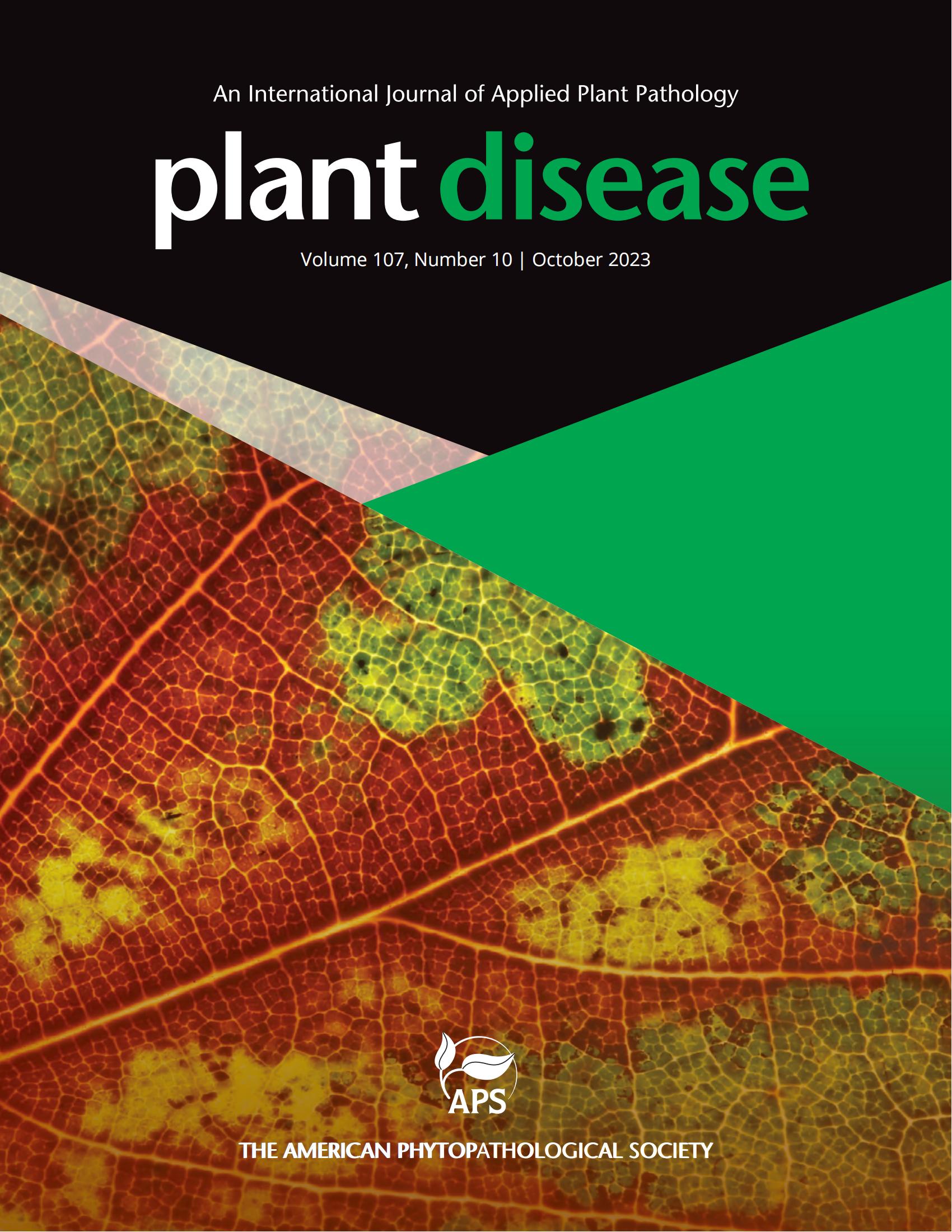意大利首次报告柑橘上的柑橘黄脉清病毒 (CYVCV)。
摘要
2024 年 3 月,在帕尔马坎帕尼亚(意大利坎帕尼亚大区)一个私人花园中种植的六棵柠檬树(Citrus limon (L.) Burm.其症状与由柑橘黄脉清病毒(Potexvirus citriflavivenae,CYVCV)(Potexvirus属,Mandarivirus亚属)引起的黄脉清病极为相似(Loconsole等人,2012;Cui等人,2018)。CYVCV 在巴基斯坦、印度、中国、伊朗、土耳其、韩国和美国均有报道(Abrahamian 等人,2024 年;Catara 等人,1993 年;EPPO,2024 年;Sun 和 Yokomi,2024 年;Jin 等人,2024 年)。自 2022 年以来,考虑到这种新出现病毒的潜在影响,CYVCV 已被列入欧洲农药残留组织的警戒名单,而在该病毒不受管制的欧盟成员国中,还没有任何关于该病毒的报告。为确定是否感染了 CYVCV,采集了叶片样本,并通过反转录聚合酶链反应(RT-PCR)进行检测。采用硅胶捕获提取法(Foissac 等人,2001 年)从生长在同一花园的有症状柠檬和无症状柠檬及甜橙(Citrus sinensis (L.) Osbeck)树叶中提取总核酸(TNAs)。使用由 Chen 等人(2014 年)设计的针对衣壳蛋白基因的 CYVCV 特异引物(表 S1),通过 RT-PCR 对 TNA 进行检测。来自同一花园的所有有症状树木和一个无症状甜橙的检测结果均呈阳性,产生了预期大小(612 bp)的扩增片段。对从两棵有症状的柠檬和一棵无症状的甜橙(An PP842725-PP842727)上获得的扩增子进行直接 Sanger 测序,然后进行 BLAST 搜索,结果显示,这些扩增子与之前从加利福尼亚州的一棵柑橘(An OQ418501)和一棵柠檬(An OQ418493)上分离出的 CYVCV 有 97.9-98.08% 的序列同一性(查询覆盖率 100%)。相反,在无症状柠檬树的样本中未检测到扩增子。用不同的引物(表 S1)对 CYVCV 的 RNA 依赖性 RNA 聚合酶基因进行 RT-PCR 扩增,确认了病毒的特征。通过 Sanger 序列测定(An PQ284953-PQ284955),其序列与之前从新德里的柑橘(An OR251443)中报告的 CYVCV 序列有 97.98-98.11% 的一致性(查询覆盖率 100%)。由于 CYVCV 是通过昆虫传播的(Önelge 等人,2011a,2011b;Zhang 等人,2018,2019),因此使用 Chen 等人(2014)设计的引物对,通过 RT-PCR 对侵染有症状柠檬的 Aphis aurantii 以及侵染有症状柠檬和无症状甜橙树的 A. spiraecola 和 Dialeurodes citri 的 TNAs(Foissac 等人,2001)进行了检测。对每种昆虫检测了来自三棵不同树木的 15 份样本。对扩增子(An PP842721-PP842724)的直接测序证实了病毒的性质,并表明昆虫源病毒序列与感染树木的病毒序列具有 99.3-100% 的核苷酸同一性。总之,这些数据证明意大利南部存在 CYVCV。它很可能是通过受感染的柑橘繁殖材料非法传入的。鉴于在检测到 CYVCV 的地区有大量 A. aurantii 和 A. spiraecola 种群,预计病毒会迅速传播到坎帕尼亚大区的其他地区。尽管 CYVCV 对意大利柑橘生产的影响仍有待评估,但及时、广泛的调查可能有助于确定病毒的实际分布情况。这将有助于更好地评估应采取的适当措施,以实现柑橘的可持续生产。据我们所知,这是意大利和欧盟境内首次报告 CYVCV。In March 2024, symptoms of vein clearing (Fig. S1) were observed on leaves of six lemon (Citrus limon (L.) Burm. f.) trees grown in a private garden in Palma Campania (Campania region, Italy). Symptoms strongly resembled those of yellow vein clearing disease, caused by Potexvirus citriflavivenae (citrus yellow vein clearing virus, CYVCV), genus Potexvirus, sub-genus Mandarivirus (Loconsole et al., 2012; Cui et al., 2018). CYVCV was reported in Pakistan, India, China, Iran, Turkey, Korea and USA (Abrahamian et al., 2024; Catara et al., 1993; EPPO, 2024; Sun and Yokomi, 2024; Jin et al., 2024). Since 2022, considering the potential impact of this emerging virus, CYVCV has been included in the EPPO alert list and it has not been reported in any European Union (EU) Member State where the virus is not regulated. To ascertain possible infection with CYVCV, leaf samples were collected and tested by reverse transcription polymerase chain reaction (RT-PCR). Total nucleic acids (TNAs) from leaves of the symptomatic lemon and non-symptomatic lemon and sweet orange (Citrus sinensis (L.) Osbeck) trees grown in the same garden, were extracted using the silica-capture extraction method (Foissac et al. 2001). TNAs were tested by RT-PCR using CYVCV specific primers (Table S1) designed by Chen et al., (2014) targeting the coat protein gene. All symptomatic trees and an asymptomatic sweet orange from the same garden tested positive generating an amplicon of the expected size (612 bp). Direct Sanger sequencing of amplicons obtained from two symptomatic lemons and one non-symptomatic sweet orange (An PP842725-PP842727) followed by BLAST search showed 97.9-98.08% sequence identity (query coverage 100%) with CYVCV isolates previously reported from a mandarin (An OQ418501) and a lemon (An OQ418493) in California. In contrast, no amplicons were detected in samples from non-symptomatic lemon trees. Virus identity was confirmed by RT-PCR with different primers (Table S1) targeting the RNA-dependent RNA polymerase gene of CYVCV. Amplicons of the expected size (832 bp) were obtained only from samples previously tested positive to the virus and their sequences determined by Sanger sequence (An PQ284953-PQ284955) showed 97.98-98.11% identity (query coverage 100%) with CYVCV sequence previously reported from a mandarin (An OR251443) in New Delhi. Since CYVCV is transmitted by insects (Önelge et al., 2011a, 2011b, Zhang et al., 2018, 2019), TNAs (Foissac et al., 2001) from Aphis aurantii infesting symptomatic lemons, and of A. spiraecola and Dialeurodes citri infesting symptomatic lemon and non-symptomatic sweet orange trees were assayed by RT-PCR with primer pairs designed by Chen et al., (2014). Three samples of 15 specimens from three different trees were tested for each insect. In contrast to D. citri, which tested negative, an amplicon of 612 bp was detected from A. aurantii and A. spiraecola and Direct sequencing of amplicons (An PP842721-PP842724) confirmed the nature of the virus and showed that insect-derived viral sequences shared nucleotide identity of 99.3-100% with those from the infected trees. Altogether, these data support that CYVCV is present in Southern Italy. Likely, it has been introduced illegally through infected citrus propagation material. Given the large A. aurantii and A. spiraecola populations in the areas where CYVCV has been detected, a fast spread of the virus to other areas of Campania region can be expected. Even if the impact of CYVCV on citrus production in Italy remains to be assessed, prompt and extensive surveys may be helpful to establish the actual distribution of the virus. This would allow for a better evaluation of appropriate measures to be adopted to achieve sustainable citrus production. At the best of our knowledge, this is the first report of CYVCV in Italy and in the EU territory.

 求助内容:
求助内容: 应助结果提醒方式:
应助结果提醒方式:


